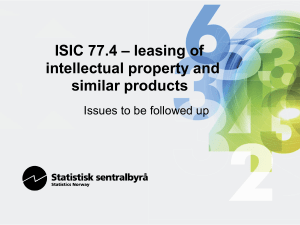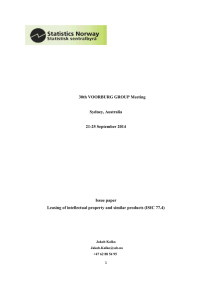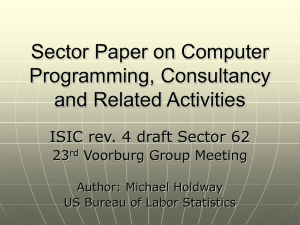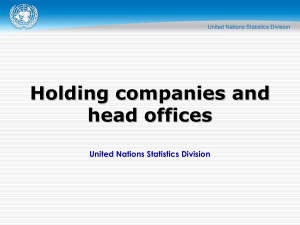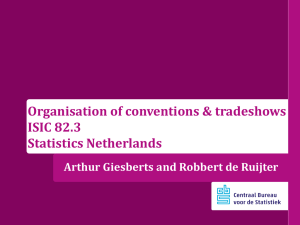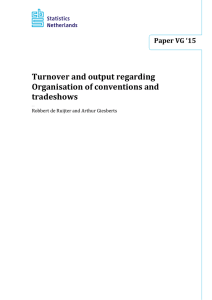30 Voorburg Group Meeting Office Administrative and Support Activities (ISIC 821)
advertisement
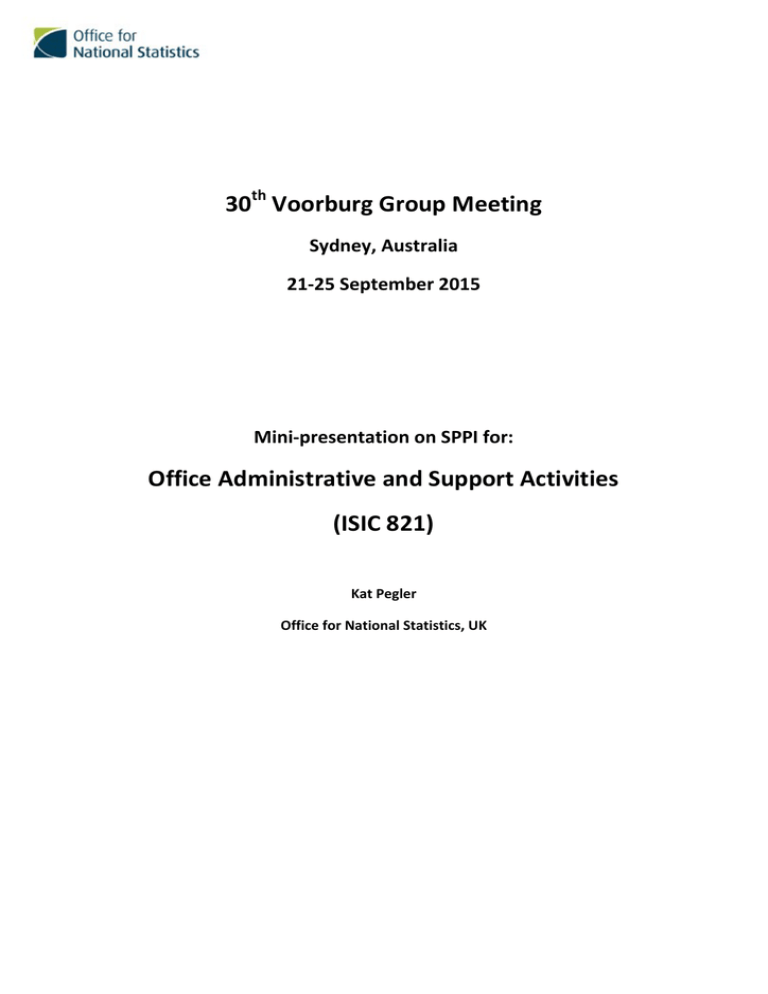
30th Voorburg Group Meeting Sydney, Australia 21‐25 September 2015 Mini‐presentation on SPPI for: Office Administrative and Support Activities (ISIC 821) Kat Pegler Office for National Statistics, UK 1. Introduction The purpose of this paper is to briefly describe the approach and any difficulties associated with measuring price change for Administrative and Support Activities in the UK. An SPPI for Secretarial Services was developed in the mid‐1990s, which is similar in scope to Administrative and Support Activities but since this industry is not significant in the UK economy and this SPPI is not currently used as a deflator in the National Accounts, it has received relatively little attention since it was developed. Therefore the main challenge highlighted for us in this industry is the resource and mechanism required to maintain SPPIs, particularly where they are of little importance to the economy. 2. Market characteristics and constraints In the UK, Office Administrative and Support Activities represent approximately 0.1% of GDP. According to the UK Business Register, there are around 5,000 companies classified to ISIC 821, generating turnover of around £2.8 million. In terms of the number of companies operating in this industry, the vast majority (92%) have fewer than 10 employees, however, over 42% of the turnover is generated by large companies with at least 300 employees (table 1). Table 1. Companies classified to ISIC 821 on the UK Business Register, by number of employees Employees Companies Turnover 0‐9 4765 739,222 10‐49 310 466,099 50‐99 41 178,065 100‐299 24 264,231 >300 8 1,217,790 Total 5148 2,865,407 Companies % 92.6 6.0 0.8 0.5 0.2 100 Turnover % 25.8 16.3 6.2 9.2 42.5 100 3. Classification Office Administrative and Support Activities (ISIC 821) is one of four groups that make up ISIC division 82 – Office administrative, office support and other business support activities. It includes the provision of a range of day‐to‐day office administrative services, such as financial planning, billing and record keeping, personnel and physical distribution and logistics for others on a contract or fee basis. The group also includes support activities for others on a contract or fee basis, that are ongoing routine business support functions that businesses and organizations traditionally do for themselves. Units classified in this group do not provide operating staff to carry out the complete operations of a business. Units engaged in one particular aspect of these activities are classified according to that particular activity. The ISIC (rev 4) and NACE (rev 2) classifications break Office Administrative and Support Activities into two classes: ISIC (rev 4) Group 821 – Office administrative and support activities Class 8211 – Combined office administrative service activities Class 8219 – Photocopying, document preparation and other specialised office support activities There is no direct alignment between ISIC and NACE and NAICS (2012) and ANZSIC (rev 2) so that making comparisons at the group level or higher is difficult. For ANZSIC, Office Administrative and Support Activities is split across two classes (7291 and 7292) that feed into group 729 – Administrative services: ANZSIC (rev 2) Group 729 – Administrative services Class 7291 – Office Administrative Services Class 7292 – Document Preparation Services Class 7293 – Credit Reporting and Debt Collection Services Class 7294 – Call Centre Operation Class 7299 – Other Administrative Services n.e.c. For NAICS, Office Administrative and Support Activities is also split between two classes (5611 and 5614) that feed into Group 561 – Office Administrative Services. However, Class 5614 also includes activities that are not classified under ISIC 821 such as call centres and credit bureaus. NAICS (2012) Group 561 – Administrative and Support Services Class 5611 – Office Administrative Services Class 5612 – Facilities Support Services Class 5613 – Employment Services Class 5614 – Business Support Services Class 5615 – Travel Arrangement and Reservation Services Class 5616 – Investigation and Security Services Class 5617 – Services to Buildings and Dwellings Class 5619 – Other Support Services 3. Compilation of SPPI 3.1 UK Index In the UK, we produce an index for Secretarial Services, which was developed in around 1995 when our approach was to develop indices where we thought price change was easiest to measure before tackling more complex industries. Prices are collected using a business survey and the index structure is made up of six categories which are similar in content to ISIC 821: Response Management (weight 5.0%) – Includes, for example: sifting, acknowledging and handling of applicant responses to a recruitment exercise for a client company; and managing and responding to customer emails to a client company. Laser Personalisation (weight 15.1%) – This service uses laser printing to personalise any type of material, such as printing labels, letterheads, envelopes, leaflets, brochures, plastic membership cards or printing personalised letters with digitised signatures. Fulfilment Solutions (weight 7.1%) – This service assists businesses in the management of orders and deliveries – ie the control, monitoring and tracing of the flow of merchandise through the supply chain. Polythene Mailing Solutions (weight 2.3%) – This service covers polythene wrapping services for mailings, magazines, brochures, catalogues etc and can include enclosing inserts and promotional items. This includes insertion, addressing and usually mailing. Paper Enclosing and Mailing Services (weight 30.0%) – This is mainly the insertions of documents, such as letters into envelopes using machinery, followed by the addressing, labelling and mailing of the envelopes. Other (weight 40.6%) 3.2 Pricing mechanisms The most prevalent pricing mechanism used within the UK Secretarial Services SPPI is a unit value price, for example, price per 1000 envelopes posted or price per customer details captured. Contract pricing is also used, for example, the price for a contract to handle all fulfilment services including inbound customer calls, label printing, order picking and delivery of items. We also see services priced based on the time spent in the provision of the service, for example, the price per hour. In the UK, we use a mixture of pricing methods to capture these: direct use of repeated services; contract pricing; and time based methods. 3.3 Problems associated with UK measurement of prices One of the biggest challenges we face in the UK is maintaining our indices, since, in the past, we have focused on developing new indices rather than maintaining our existing indices. Since our Secretarial Services index was developed around 20 years ago, changes in classifications and the industry itself means that we are now not clear that our index is really representative of ISIC 821. We don’t currently have a mechanism by which to update our aggregation structures, which means that it is now not clearly aligned with the UK Standard Industrial Classification (which aligns to ISIC). We also have a relatively large amount of activity (around 40% of turnover) in our ‘other’ category suggesting that our structure is no longer fully representative of the industry. This ‘other’ category currently includes activities such as financial processing and telephone answering services. Furthermore, since Office Administrative and Support Activities represents just 0.1% of the UK economy and this index is not currently used as a deflator within the National Accounts (though this may change in the future), it is difficult to justify assigning resources to this index when resources are in such short supply. In terms of the regular collection of prices for our Secretarial Services SPPI, we find it to be fairly straightforward and have no clear problems with data quality or quality adjustment. 3.4 Summary Administrative and Support Services represents a very small part of the UK economy and the measurement of prices, which is implemented as a Secretarial Services SPPI, presents very few problems, with a unit value price, captured as direct use of repeated services, the most prominent pricing mechanism. The UK Secretarial Services index was developed around 20 years ago and highlights the problems associated with maintaining SPPIs, particularly when they are of relatively little importance to the economy and devotion of resources to them is difficult to justify.
